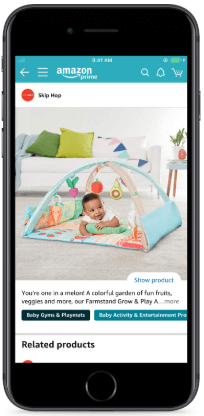As part of its ever-expanding repertoire, Amazon has added a feed-based shopping experience with Amazon Posts. Here is a quick rundown of what the program is, the current state of tools and capabilities, and how brands should approach it moving forward.
What is Amazon Posts?
Released as a beta in 2019, Amazon Posts is a new brand discovery experience. It features lifestyle or branding imagery as the creative while landing shoppers on a product detail page. Posts can be found on an advertiser’s own brand detail page, related brand detail pages, category-based post feeds, and feeds for related posts directly on a product detail page (PDP). This feed essentially creates a shopping experience, driven by branded content, directly on the Amazon.com domain.

How brands should approach Posts
Amazon really wants advertisers to lean into its new branding experiences, so it is making it extremely easy for brands to get up and running. By using the same creative specifications as other channels, like Facebook, Amazon made it simple for brands already creating content to load it directly on Amazon to participate in Posts. To further encourage participation, Amazon is offering this placement to brands for free (at least for now). Brands should take advantage of this cost-free period now. Once Amazon can make this an experience with which shoppers heavily engage, it’s likely to be monetized.
A key consideration to keep in mind is that Posts are eligible to show on related PDPs, meaning competitors could be showing Posts on a page for one of your products. To protect your own PDPs from competitor brands, all brands should consider launching a campaign if they have usable existing content. To take your posts to the next level, test some creative deviation from other brand collateral to see what resonates with customers. Even though Amazon Posts content looks like some paid social platforms, it doesn’t offer social engagement and differs from channels like Facebook and Instagram in other key ways. One is that users are on a platform that is primarily used for shopping, not one that’s primarily used for social engagement. Another is that these ads are likely to show alongside a competitor, rather than between photos or posts from friends and family. With those two differences in mind, it’s worthwhile to test some ad variants with clearer calls to action or more concrete product/brand differentiators.
Targeting and measurement options
With any free ad placement, there’s usually a trade-off or two. For Amazon Posts, the trade-offs are limited options for target and performance evaluation. Amazon is automatically categorizing ads, so brands do not have direct control over what category tags get flagged for their posts. Additionally, Amazon is providing limited data on how these placements are performing, with only impressions, clicks, and click-through rate available. Advertisers get no insight into revenue or orders, making it quite difficult to understand how these placements are contributing to the overall business.
Challenges
There aren’t any inherent challenges in creating Posts. The main challenge facing Amazon Posts is changing shoppers’ behavior. Amazon has long been a transaction-based site where consumers go to get something at a low price, delivered quickly. Over the past couple of years, Amazon has made efforts to shift consumer behavior by letting brands tell their story through Stores, Sponsored Brand betas, and other programs. However, unless Amazon can make these components more native and integrated with the shopper experience, there will be limited opportunities for brands to engage with potential customers.
The bottom line
If your brand has social content created, adding Amazon Posts into the channel mix is an easy way to get some real estate on one of Amazon’s newest placements. With the current cost being free, take advantage of any creative learnings while you aren’t paying for them, but don’t expect to gain a ton of insights on what drives engagement or revenue. Looking at the bigger picture, Amazon is investing in a Brand Shopping Experience across its platform and Posts will be an asset to watch as they introduce additional features and ways for shoppers to engage.
The post Amazon Posts: A feed-based shopping experience on Amazon appeared first on Search Engine Land.
Source: IAB

